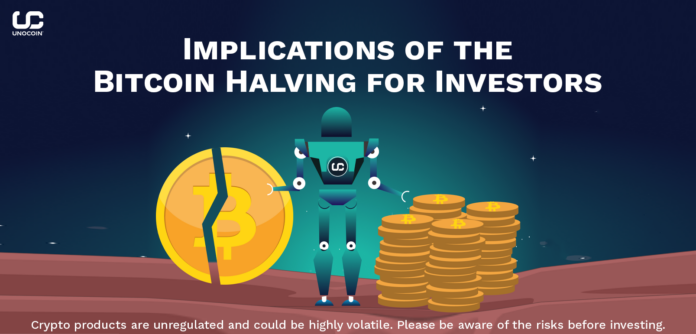On April 19, 2024, the world witnessed a major digital asset event: the fourth halving of Bitcoin. However, unlike the previous halves, this one passed without major hiccups. There were no bells, no fireworks lighting up the sky. Instead, the event played out quietly, leaving many investors wondering about its implications for the future of cryptocurrency.
The bitcoin halving is a four-year event where the block reward for miners is halved, reducing the rate at which new bitcoins enter circulation. This built-in scarcity mechanism is fundamental to Bitcoin’s design and has long-term implications for miners, traders, and investors.
While the immediate impact of the halving may not be obvious to most investors, it significantly affects Bitcoin miners. With their block rewards cut in half, miners face reduced profitability, leading to adjustments to their operations and potentially reshaping the mining industry.
Beyond the immediate effects on miners, however, the halving event has broader implications for the supply and demand dynamics of Bitcoin. The reduction in new supply increases the scarcity of Bitcoin, which may put upward pressure on its price in the long run. However, the relationship between halving events and price appreciation is complex and influenced by various market factors.
Megan Stals, market analyst at trading platform Stake, notes that bitcoin trading volume typically spikes in the months leading up to the halving as interest and prices gain momentum. This trend was evident in March 2024 with a significant increase in trading volume as investors sought greater exposure to Bitcoin.
Before the halving, the price of Bitcoin saw some fluctuations, dropping from over $67,000 to $62,000. Despite a stable price of around $64,000 after the halving, individual miners, especially smaller operations, have faced problems due to increased mining costs and reduced block rewards.
Stals emphasizes the importance of investing in new hardware and energy-efficient solutions for the long-term sustainability of miners. Additionally, the US Securities and Exchange Commission’s (SEC) approval of bitcoin exchange-traded funds (ETFs) in January 2024 has made it easier for investors, especially older ones, to gain exposure to bitcoin without going through cryptocurrency exchanges.
However, Bitcoin remains sensitive to broader market trends such as changes in interest rates. Concerns about inflation and the Federal Reserve’s monetary policy can affect investor sentiment and, in turn, Bitcoin’s price trajectory.
Investors should consider historical trends and market dynamics when analyzing the implications of a halving. While the price of bitcoin has historically risen after halvings, the path to new all-time highs is rarely linear. Price volatility due to factors such as institutional activity and whaling can be expected in the coming weeks and months.
Additionally, as the market adjusts to new supply dynamics, increased volatility is expected. Investors should adopt a prudent investment strategy that manages risk and maintains a long-term perspective on Bitcoin’s potential as a digital asset.
Looking back at previous halving events, Bitcoin saw significant price appreciation in the months following each halving. Since then, however, the cryptocurrency market has evolved with increased institutional participation and regulatory scrutiny.
In conclusion, while the fourth bitcoin reduction may have happened quietly, its long-term implications are profound. As investors navigate the evolving crypto asset landscape, they must remain vigilant, adapt their strategies and monitor market developments to take advantage of opportunities and mitigate risks in this dynamic space.
Please find the list of authentic Unocoin accounts for all your queries below:
- Twitter: https://twitter.com/Unocoin
- Instagram: https://www.instagram.com/unocoin/
- Facebook: https://www.facebook.com/unocoin/
- LinkedIn: https://in.linkedin.com/company/unocoin
- YouTube Channel: https://www.youtube.com/c/Unocoin/videos
- Newsletter: https://medium.com/subscribe/@Unocoin_growth
- Blogs: https://blog.unocoin.com
- Telegram Group: https://t.me/Unocoin_Group
- Telegram Channel: https://t.me/+fasQhTKBsfA5N2Zl
- Telegram: https://t.me/UnocoinSupport_Bot
- E-mail id: [email protected]
- Contact details: 7788978910 (09:30 AM IST – 06:30 PM, Mon-Sat)
- App store link: https://apps.apple.com/us/app/unocoin/id1030422972?ls=1
- Playstore link: https://play.google.com/store/apps/details?id=com.unocoin.unocoinwallet
Disclaimer: Crypto products are unregulated as of this date in India. They could be highly volatile. At Unocoin, we understand that there is a need to protect consumer interests as this form of trading and investment has risks that consumers may not be aware of. To ensure that consumers who deal in crypto products are not misled, they are advised to DYOR (Do Your Own Research).




![Fundamental Analysis in Crypto [Updated Guide] A Comprehensive Guide to Asset Valuation.png](https://blog.unocoin.com/wp-content/uploads/2024/11/A-Comprehensive-Guide-to-Asset-Valuation-218x150.png)